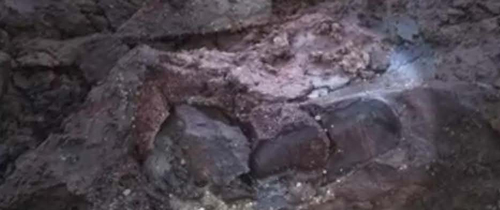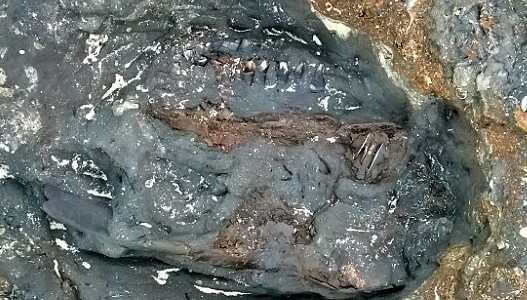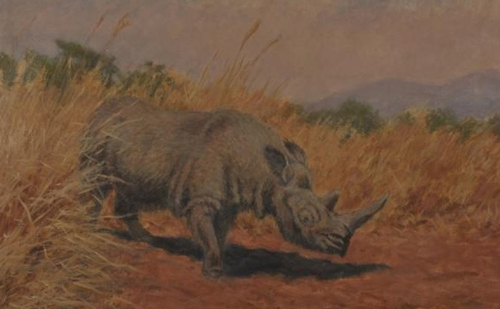Storms Reveal Rhino Remains
The recent storms and high tides have further eroded the cliffs at the West Runton beach (Norfolk, East Anglia), revealing the beautifully preserved remains of a neck bone from an ancient rhinoceros that roamed this part of England around 700,000 years ago. The fossilised remains of a single neck bone, the atlas (cervical 1), was spotted and local volunteers in collaboration with fossil conservation experts have carefully excavated and removed the rare find.
Spotted on West Runton Beach – A Fossil Neck Bone from a Rhino
Picture credit: Martin Warren
West Runton Beach
The Norfolk cliffs at West Runton, just west of the town of Cromer are world-famous for their Pleistocene Epoch exposures, particularly the, peaty Upper Freshwater Bed which has produced a huge variety of vertebrate and invertebrate fossil remains. Fossil expert and former curator at the nearby Cromer Museum, Martin Warren explained:
“There has been quite a bit of interest in scouring the Cromer cliff area for geological finds recently. In the aftermath of storms, more people are coming to see what they can find, but the West Runton Freshwater Bed is a precious scientific resource.”
The area has SSSI status (Site of Special Scientific Interest) and hammering or digging into the cliffs is strictly forbidden. However, time and tide is exposing this area’s ancient fauna and flora, although no formal identification of the atlas bone has been made, it is likely the fossil comes from a Stephanorhinus hundsheimensis, a rhino whose fossils are associated with the Upper Freshwater Bed locality. A partial skull with teeth was found in January 2015, close to this new discovery. It is not known whether the neck bone and the skull represent the same animal.
The Partial Skull and Teeth of S. hundsheimensis found in Early 2015
Stephanorhinus hundsheimensis
The neck bone has been dated to a warm interglacial period known as the Cromerian Interglacial. Such is the importance of the West and East Runton beaches to geologists, that the Cromerian Interglacial was named after the nearby town of Cromer. It was from these Norfolk beaches that geologists first identified fauna and flora indicating a period of global warming in between Ice Ages.
An Illustration of the Ancient Rhinoceros – Stephanorhinus hundsheimensis
Picture credit: C. C. Flerov, Sammlungen, Senckenberg Research Institute, Research Station of Quaternary Palaeontology,Weimar
Standing around 1.2 metres high at the shoulder Stephanorhinus hundsheimensis weighed around 750 kilogrammes and it was widespread across Europe for much of the Pleistocene Epoch. Regarded as a generalist, living in both forest and more open habitats, this rhino, which was named from a fossil site in Austria, faced increasing competition when two, more specialised types of rhinoceros evolved.
Stephanorhinus kirchbergensis, also known as the Merck’s rhinoceros, began to displace the Hundsheim rhino in forest habitats and the Steppe rhino (Stephanorhinus hemitoechus) gradually replaced S. hundsheimensis on the grasslands. One ancient rhino was superseded by better adapted species of rhinoceros, Stephanorhinus hundsheimensis became extinct around 580,000 years ago.
A spokesperson from Everything Dinosaur commented:
“Hopefully this new fossil will shed further light on the remarkable fauna of East Anglia during the Pleistocene Epoch. Although we advise care, especially around the cliffs, local fossil hunters and collectors can often spot important specimens that might otherwise get washed into the sea.”
For models and replicas of prehistoric rhinos and other Pleistocene mammals: Wild Safari Prehistoric World Figures.









Leave A Comment